Overview
- Medication Errors and Patient Safety.
- What is CPOE?
- How can CPOE Improve the Healthcare System?
- Related Benefits and Challenges.
- SWOT.
- CPOE Implementation.
- Risks Mitigation Strategies.
There is no doubt that modern healthcare system is not perfect in terms of the outcomes for patients. In fact, the inability of healthcare specialists to minimize the impact of the human factor and the use of solutions involving significant challenges has a detrimental influence on the present condition of the healthcare system.
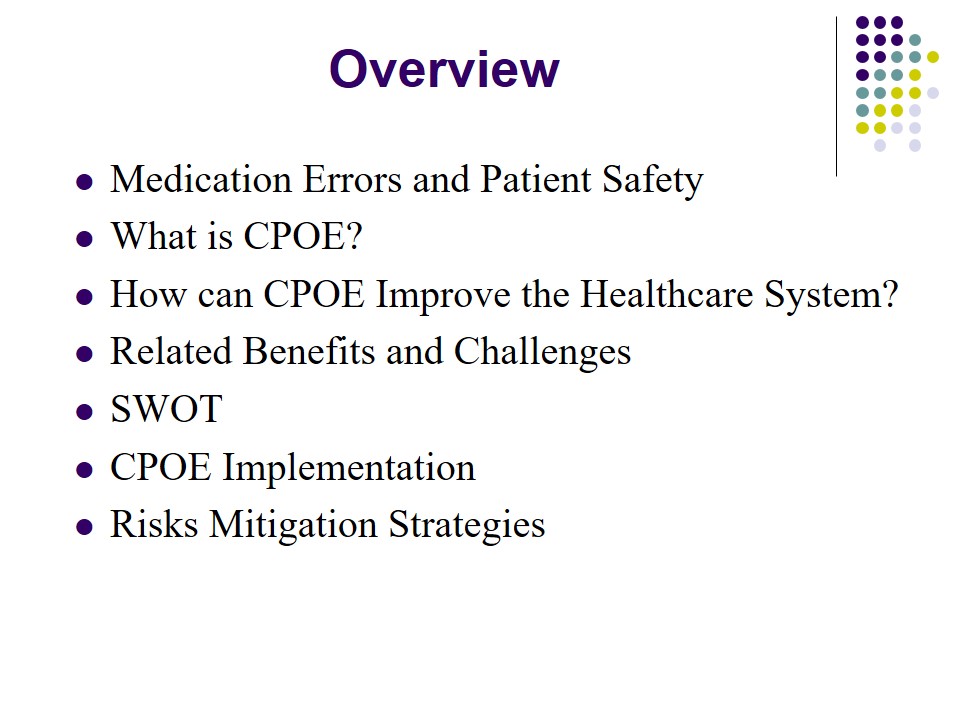
Target Audience
- Hospital personnel at all levels:
- “C Level” − CEO, CTO, CSO, etc.
- Service Management − Hospital operations and Quality Assurance Executives, etc.
- Business Management.
- Heads of Medical Department.
Although safety culture can be improved only through everyday practices of health care personnel, without the managerial and leadership support and understanding of the issue, there will be no progress. Moreover, the integration of new technology, behavioral protocols, and standards requires extensive planning and supervision. Thus, it is possible to say that the role of managers and leaders is pivotal during CPOE implementation. By showing the benefits and risks associated with the integration of the technology into the hospital’s system, this presentation aims to motivate the target audience to act.
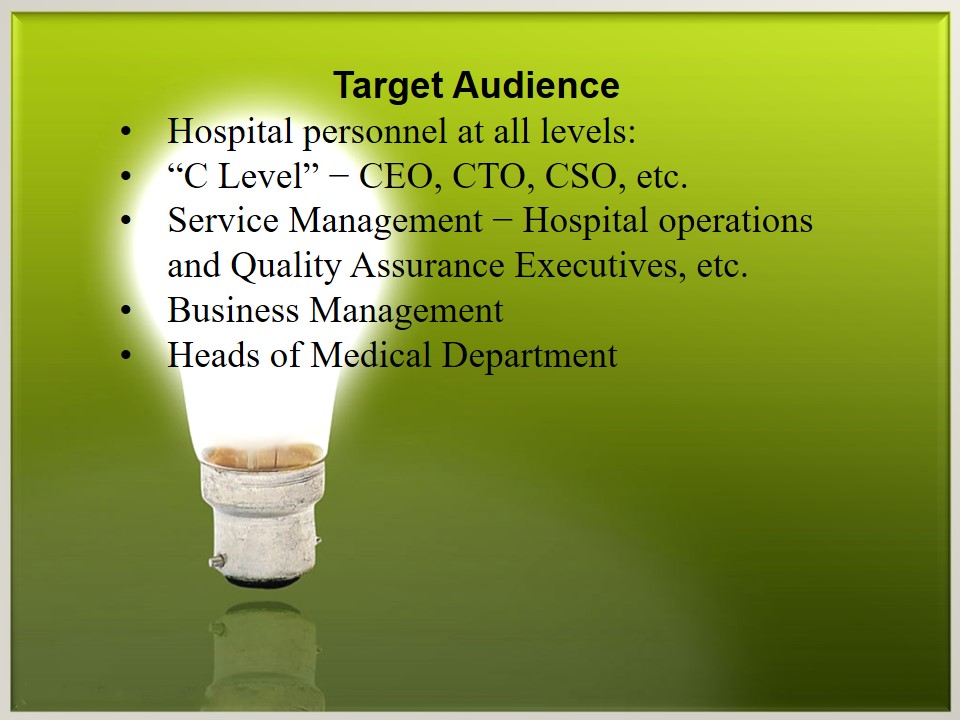
The Problem: Medication Errors
- Medication errors: the use of wrong medications or wrong dosage.
- The most common medication errors are related to the choice of patients, the right time to take drugs, and repetitive prescriptions (Wahr & Merry, 2017).
The problem of medication errors or inappropriate treatment is strictly interconnected with common mistakes and omissions related to the practical work of certain solutions. Nowadays, many researchers including Wahr and Merry (2017) regard medication errors as one of the key problems of the healthcare system as the mistakes related to dosages, incorrectly chosen patients, and medications that are prescribed repeatedly is detrimental both to patient outcomes and the level of trust to healthcare specialists. Therefore, specialists from many healthcare institutions in the country understand that the approach to the choice of HIT solutions should be improved.
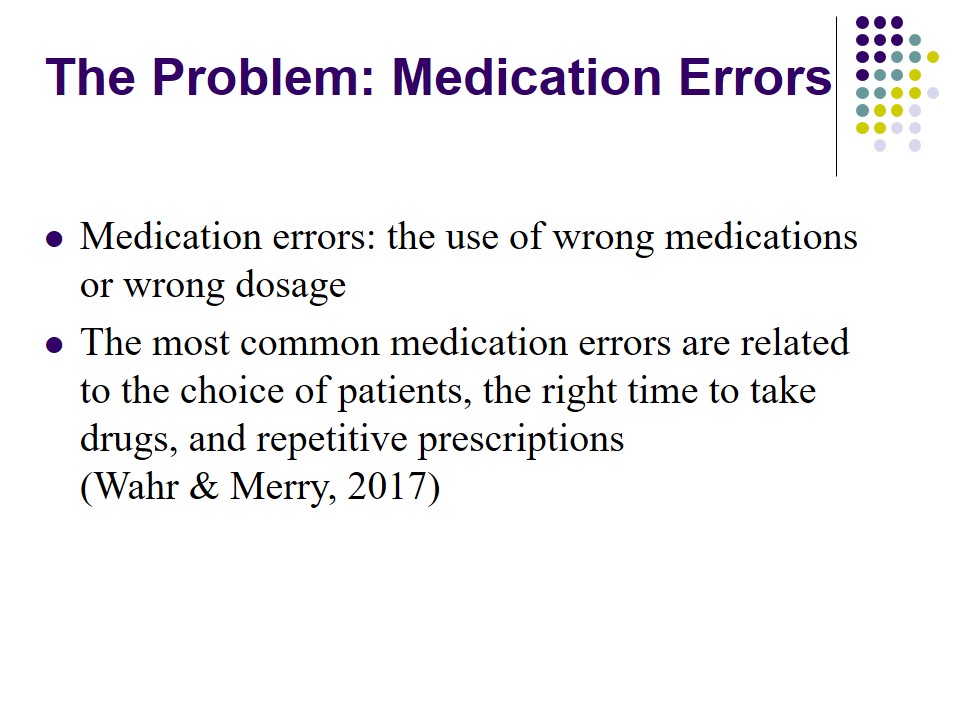
Patient Safety
- Threats to patient safety exist due to the presence of the human factor.
- The challenges to patient safety include medication errors, the lack of information on reaction to drugs, and delayed completion of orders.
It is known that patient safety is protected with a wide range of healthcare information technology innovations. The problem of patient safety cannot be analyzed separately from the topic of HIT-related innovations as the latter, together with professionalism of healthcare specialists presents the key allowing to improve patient safety in the country. The importance of patient safety studies cannot be overstated, but it needs to be acknowledged that the challenges to patient safety exist due to ineffective use of information on orders, prescriptions, and health history in healthcare institutions. To reduce the impact of negative factors identified, healthcare institutions need to adopt new IT systems with proven effectiveness.

What is CPOE?
- CPOE or Computerized Physician Order Entry is the technology that involves the exchange of data on treatment instructions and requirements with the help of CPOE software.
- The technology allows to use great amounts of information in a more effective way.
Taking into account the importance of healthcare problems discussed before, I am glad to introduce the solution that is proven to be effective for reducing the frequency of medication mistakes and their negative outcomes. Computerized Physician Order Entry is the technology that allows healthcare practitioners to exchange medical treatment guidelines to make the work of healthcare specialists less time-consuming and help them to utilize a patient-centered approach. CPOE involves the creation of the effective system ensuring a rapid order completion. Also, speaking about the most prominent features of the discussed HIT innovation, it is important to note that it provides an opportunity to integrate the information related to health history and current prescriptions to facilitate the decision-making process and reduce the number of medication mistakes.
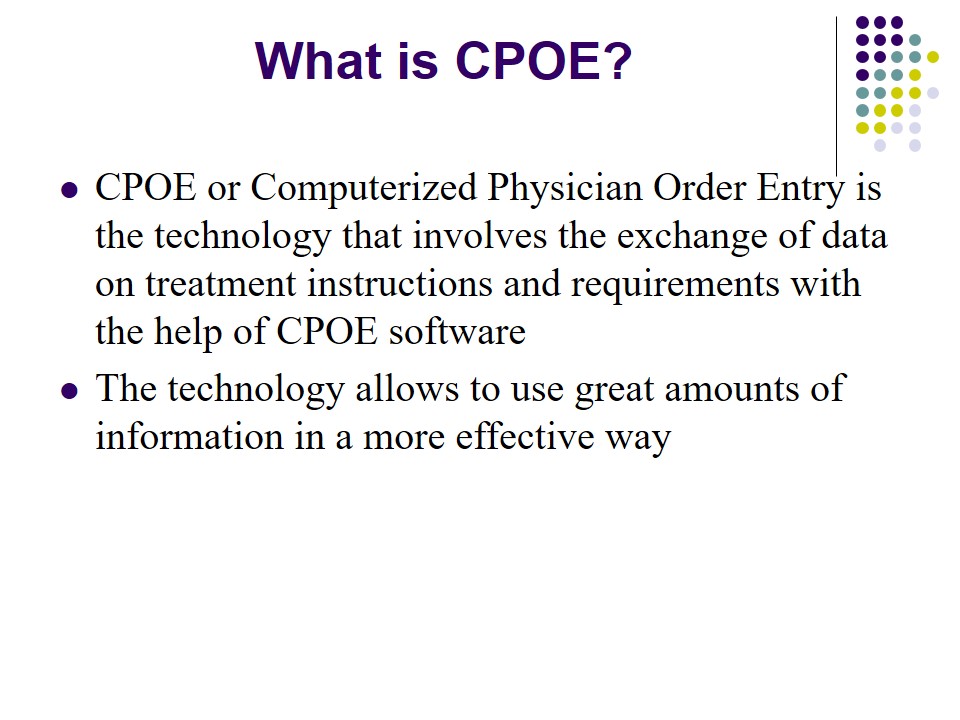
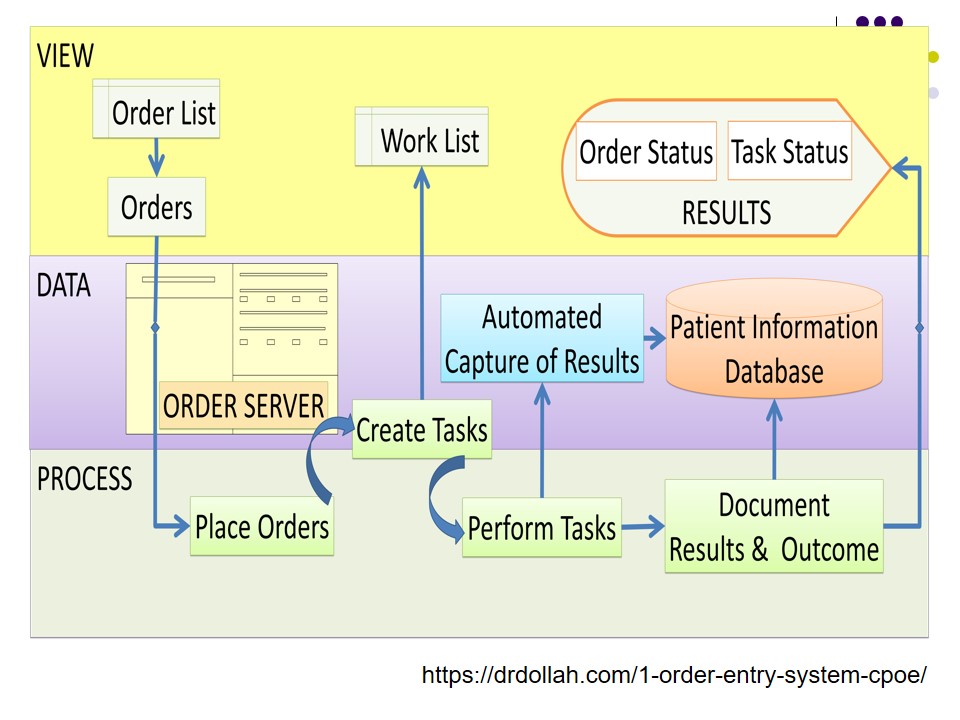
How Can CPOE Improve the Healthcare System?
- Reduce the mistakes related to the lack of unity of professional terminology.
- Estrange the mistakes that occur due to the misinterpretation of treatment instructions (Prgomet, Niazkhani, Georgiou, & Westbrook, 2016).
- Manage healthcare orders to avoid the cases of late treatment.
In fact, the discussed technology has a number of opportunities to improve the current healthcare system if implemented correctly. First, order entry practices that were utilized prior to the global development of HIT innovations provide healthcare specialists with an opportunity to use atypical terms and abbreviations. In its turn, the lack of unity of professional terminology can be listed among the primary sources of medication mistakes. The influence of the human factors and specific ways to write certain letters or numbers can be seen as the leading cause of misinterpretation of data increasing the rate of medication mistakes. What is more, the use of the technology improves patient safety as effective data integration makes the work with healthcare orders more time-consuming and goal-oriented.
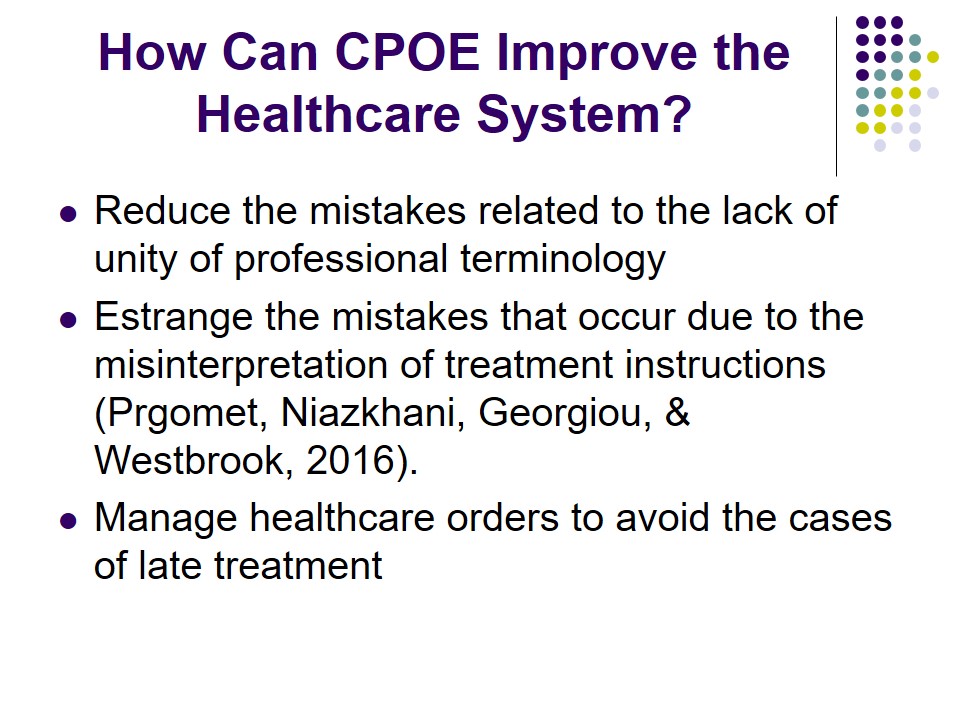
Clinical Trial Outcomes
- Legibility of physicians, orders;
- Reduced cognitive burden on physicians;
- Improved medication dosing;
- Increased appropriate use of scheduled medicaion;
- Reduced dose miscalculation.
During clinical trials, field observations, and interviews with health practitioners in hospitals implementing CPOE, Simon et al. (2013) learned that legibility of physicians’ orders was “one of the most palpable and immediate beneficial consequences” of the technology integration (p. 6). Another study by Khanna and Yen (2014) shows that by implementing simple CPOE tasks, physicians may improve the workflow and reduce the cognitive burden associated with medication prescription. The real-life research also revealed some positive effects of the use of the technology on medication dosing and adherence to pharmacological treatment (Khanna & Yen, 2014). Moreover, these direct results of CPOE implementation often lead to greater provider satisfaction and reduced length hospitalization, as well as overall better patient outcomes. However, to achieve positive results and avoid Cedars-Sinai Medical Center’s mistakes, the hospitals should promote the use of CPOE among all staff members interacting with patients and dealing with medication prescription including physicians, nurses, secretaries, and so on, and reduce the number of manual entries to avoid duplicate medications.
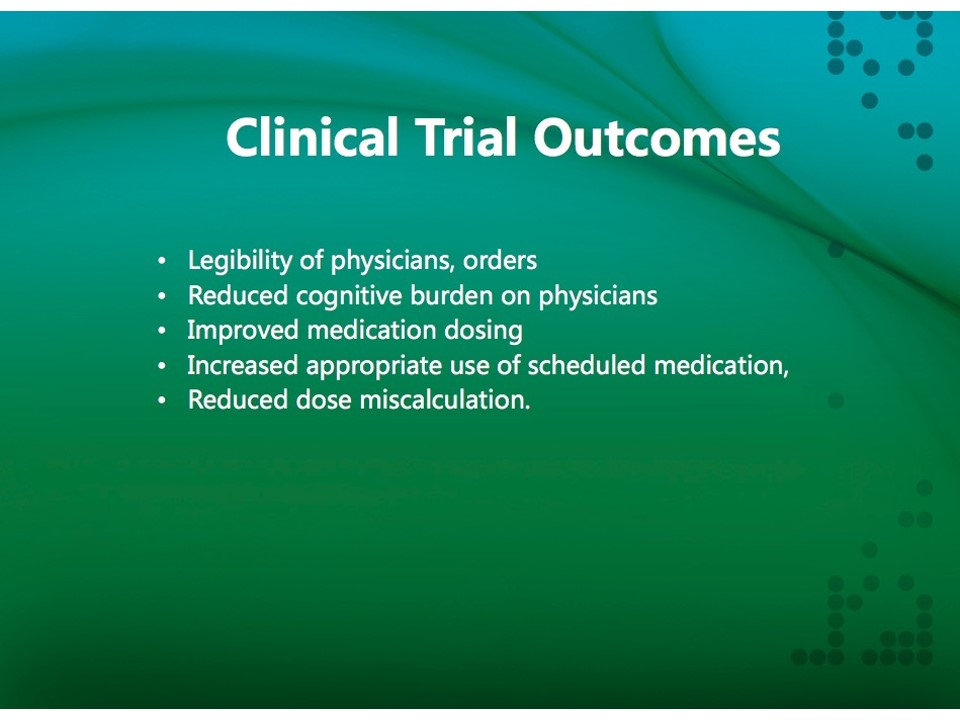
The Benefits of CPOE
- The process of information exchange between healthcare specialists is simplifiad.
- A large number of devices can be used to work with orders.
- The presence of the error checking function.
Choosing an effective strategy for HIT-related innovations, it is crucial for healthcare providers to consider the benefits and potential problems associated with the implementation of innovations. The use of CPOE in healthcare is beneficial to healthcare institutions, healthcare practitioners, and patients due to the number of advantages that it involves. In fact, the system based on CPOE makes it easier for healthcare specialists to communicate as the average response time is decreased. Another important positive feature exists because the system is portable and can be accessed by specialists even if they are far away from their working places. Also, you can work with orders using different digital devices. Finally, there is the advantage preventing users from making medication mistakes – the system double-checks new information to prevent unnecessary repetitions.
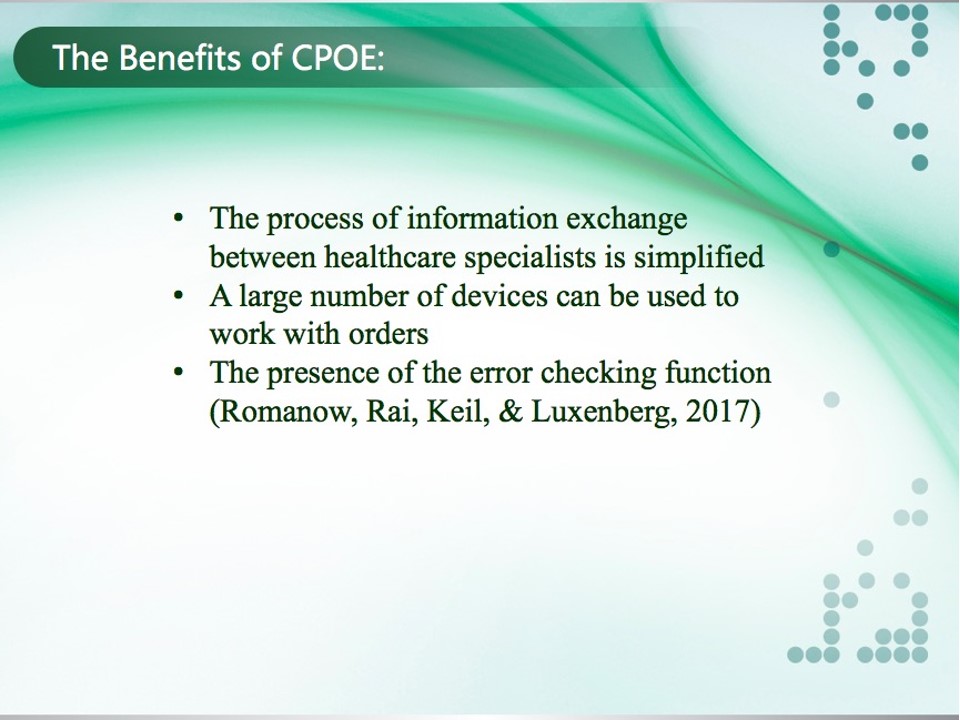
Possible Challenges
- The system cannot guarantee the absence of mistakes (therefore, users still need to double-check doubtful information).
- Considering different levels of computer literacy and adaptability of healthcare specialists, the speed of working processes may decrease for a short time (McCartney, 2014).
Unfortunately, every medal has two sides, and the implementation of CPOE may involve potential problems. Nevertheless, they can be reduced if healthcare institutions will focus more on long-term goals of its implementation. The first potential challenge that needs to be discussed is the inability of CPOE systems to identify all mistakes that can be found in treatment instructions. At the same time, the majority of studies confirm improved patient outcomes after the implementation of CPOE, and it means that every medication mistake has increased chances of being noticed by the software.
The second challenge discussed may disappoint managers of healthcare institutions who place a premium on quantity instead of quality. In fact, CPOE implementation is a significant change that requires specialists to get used to new everyday practices. Therefore, working processes may slow down for some time after the start of the implementation.
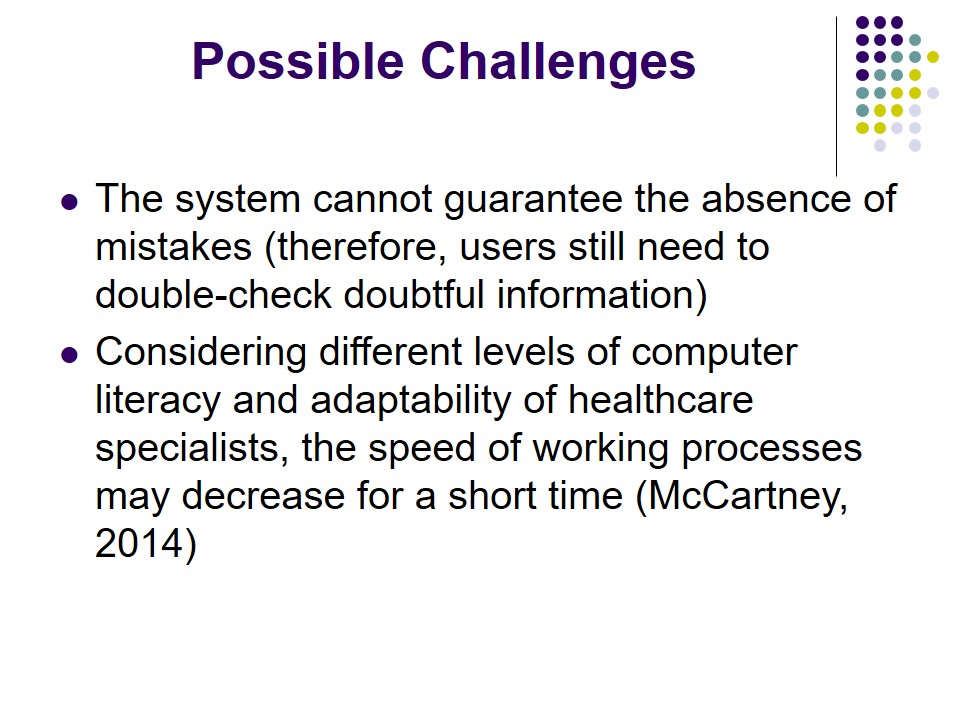
Areas of Implementation and Mortality Rates
- Types of settings associated with reduced mortality rates after CPOE implementation:
- Medical/Surgical;
- Psychiatry;
- Rehabilitation;
- Individual patient care units.
- Increased mortality:
- ICU.
CPOE can be implemented in various settings but it can lead to different results based on the character of care and specific procedures. Traditionally, “surgery and psychiatry are associated with the highest rate of dispensing errors” (Soerensen, Lisby, Nielsen, Poulsen, & Mainz, 2013, p. 27). Thus, with CPOE implementation in these types of settings, mortality rates can significantly decrease mainly because the standards of care normally actualized there were substantially referred to during the creation of specific CPOE order sets (Lyons et al., 2017). Conversely, since in ICUs patients’ conditions are characterized by increased complexity, the implementation of technology becomes more difficult. Moreover, the mortality rate can become higher at the initial stage of CPOE implementation due to the increase in practitioners’ workload. The institutional changes taking place during this phase alter the clinical workflow, e.g., nurses are required to play a greater number of professional roles and engage in offsite training (Hoonakker, Carayon, Walker, Brown, & Cartmill, 2013). As a result, they are exposed to stress, and it negatively affects their performance. Moreover, CPOE may disrupt nurse-physician communication by affecting its accuracy. However, some studies suggest that these risks can be avoided if practitioners will adapt to changes, restore feedback loops, and alter the overall way they communicate (Hoonakker et al., 2013).
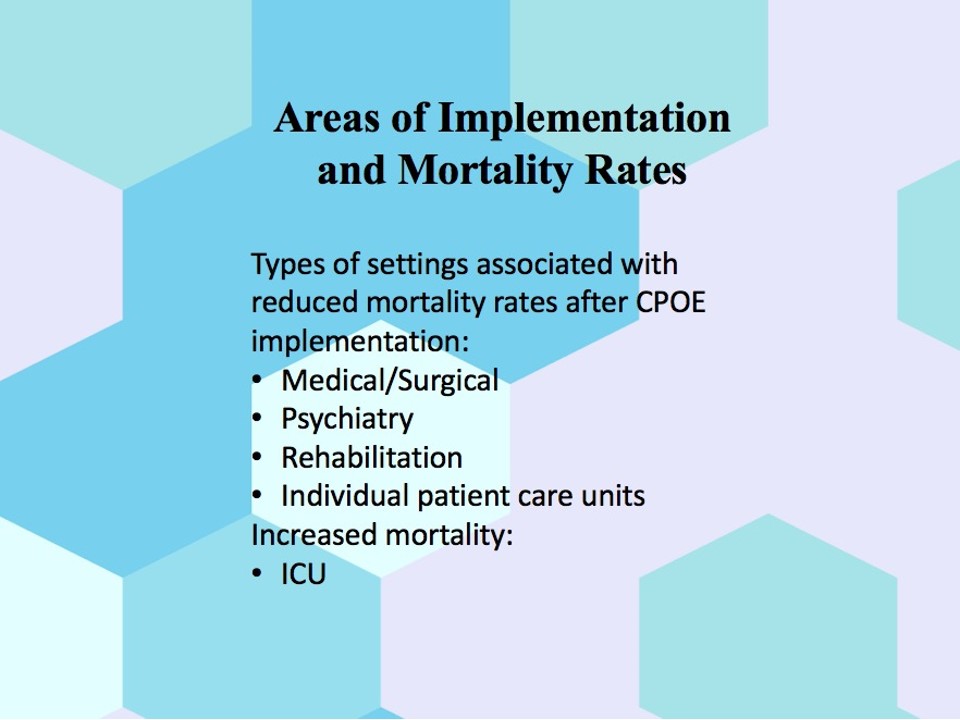
Costs
- Total cost may range from at least $ 1.9 million to $4.4 million for urban setting.
- The technology costs $265.000 less than traditional prescribing methods (Forrester, Hepp, Roth, Wirtz, & Devine, 2014).
- Reduces costs associated with medication errors.
Cost is considered the major barrier to CPOE implementation. The lowest possible cost is about $1.9 million in urban hospitals, and the highest − $4.4 million (Charles, Cannon, Hall, & Coustasse, 2014). It means that the technology can often be unaffordable for small hospitals. However, since it may have a positive effect on safety, it is associated with great cost-effectiveness and may help clinical settings save money due to the decrease in medical error rates. As stated by Forrester et al. (2014), over five years, CPOE implementation can help hospitals save up to $18 million when compared to paper prescribing. Moreover, it can significantly decrease a financial burden linked to medical errors as it is associated with “1.5 million and 14,500 fewer medication errors” than traditional prescribing methods (Forrester et al., 2014, p. 340).

SWOT
- Strengths:
- Standardized framework.
- Improved communication.
- Cost-effectiveness (Forrester et al., 2014).
- No third parties.
- Weaknesses:
- Security issues.
- Human error.
- Environment risks.
- HR skills.
- Costs.
- Implementation issues (stress, resistance to change, etc.).
- Opportunities:
- HR skills assessment.
- Improved awareness of risks and security issues.
- Learning from mistakes (Yates, 2013).
- Threats:
- Vendor-related issues.
- Bad intentions.
- A relatively new product: information shortages.
The discussed information can be used as a basis for the SWOT analysis of CPOE. In particular, the multiple positive outcomes of CPOE implementation can be summarized as its three major strengths: standardization, improved communication, and increased cost-effectiveness as compared to the paper alternative (Forrester et al., 2014). Apart from that, the fact that CPOE is an internal system implies that no third parties should be involved in it, resulting in improved security. However, this information technology can still face a variety of safety and security issues, including human errors, which can become even more prominent given the rather hectic environment of a healthcare organization that might prevent the providers from paying sufficient attention to CPOE. Costs and implementation issues are also a consideration. As a result, CPOE has some weaknesses.
The opportunities that are related to CPOE include the fact that its implementation and use are bound to improve the knowledge, understanding, and awareness of security issues and risks. Also, the adoption is likely to require the assessment of a number of pertinent skills of the users, including, for example, their ability to work with digital software. Finally, the implementation would be expected to provide some information on the mistakes that could be made before or during the process; their analysis can be helpful for the future of the organization (Yates, 2013). The major threats of CPOE adoption are related to vendors, some of which might be unreliable, bad intentions (both internal and external), which may lead to security issues, and the fact that the product is relatively new, which limits the reliable information on it. All these factors should be taken into account during the implementation process.
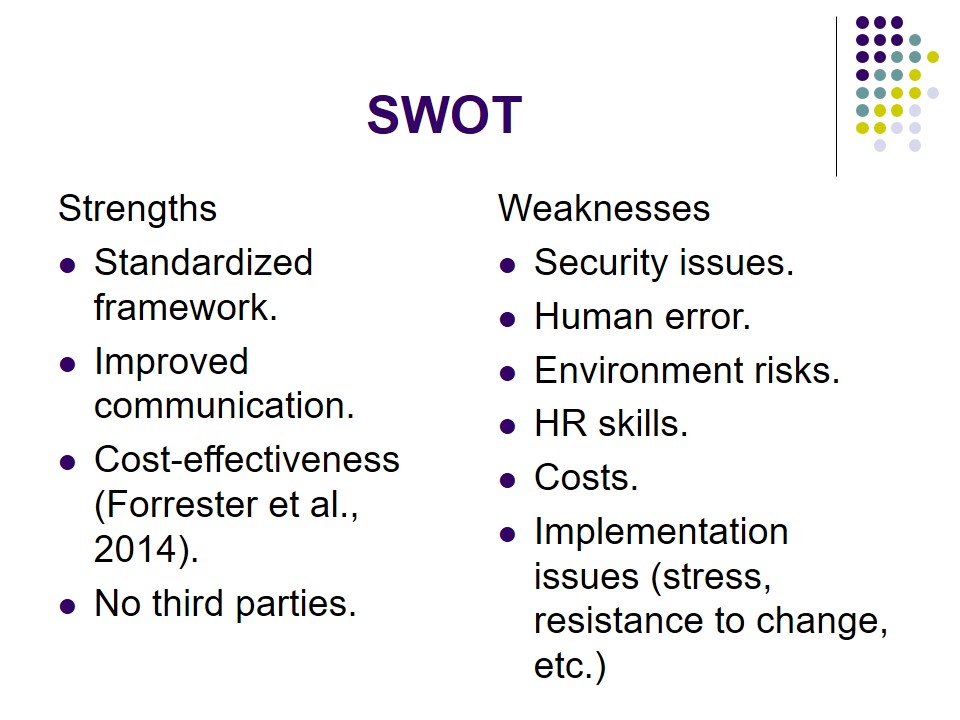
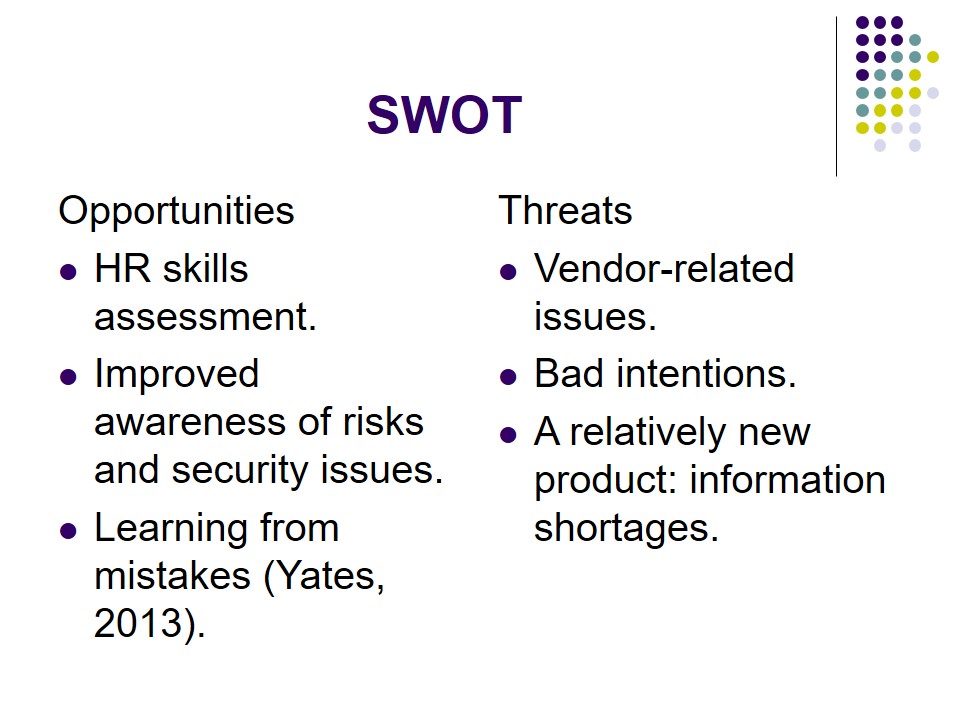
How is CPOE Implemented?
- IT governance and leadership: The assistance of innovative HIT leaders (Snedaker, 2016).
- The use of employee analysis to identify the perfect length of the training period.
- The readiness to meet changing CPOE standards.
In terms of the proper strategy that needs to be used for successful CPOE implementation, there are a few points to be paid focused attention to. First, CPOE has a great potential, but it tends to be misused; therefore, effective HIT leadership should be used to guide healthcare providers and elaborate the strategy. Next, stakeholders willing to implement CPOE systems should focus on the necessity of an appropriate training period. In its turn, its length must be defined based on the level of employees’ computer literacy and specific challenges. Finally, CPOE implementation is the task that requires concerted efforts of specialists on different levels and the willingness to meet the most recent standards.
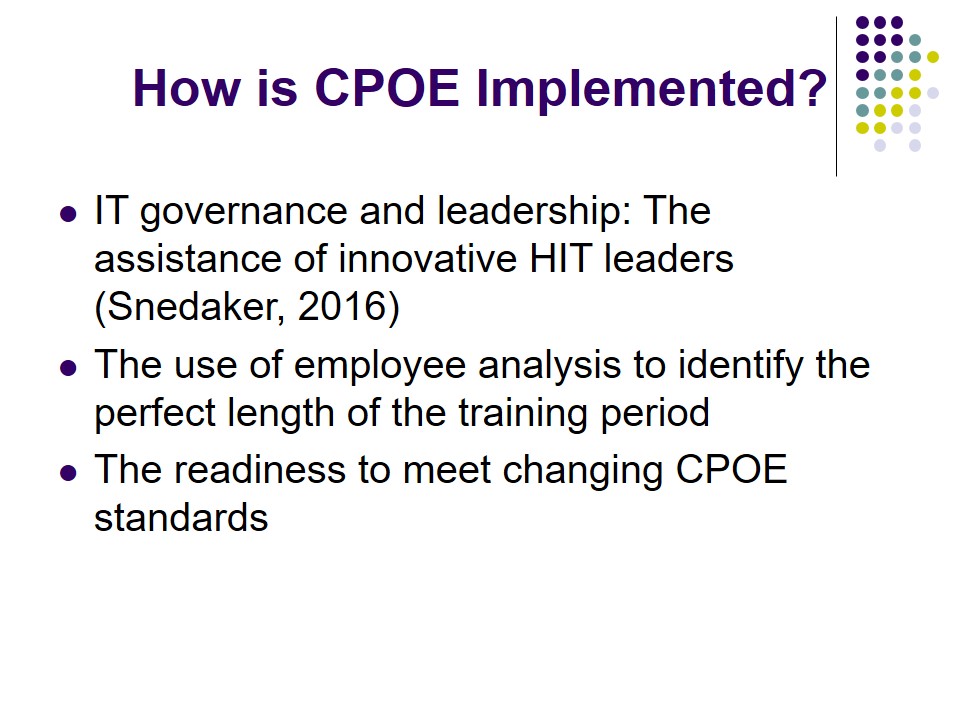
Risk Mitigation Strategies
- Education/training:
- reduces skill issues, human error/internal bad intent possibility, and stress (Kruse & Goetz, 2015);
- might affect safety and environment (safety culture).
- Standards development:
- guidelines for vendors and providers;
- improved security (Strauch, 2017).
- Research:
- vendor and costs problems solution;
- information shortages resolved.
- Leadership:
- Innovation/safety culture;
- teamwork/cooperation;
- implementation management;
- compliance (Gellert, Ramirez, & Webster, 2016).
All the mentioned elements are instrumental to the management of CPOE risks, and they can be employed in risk mitigation strategies. First, as it has been stated by the peers, education and training are an obvious solution to multiple issues. In particular, in response to Eric’s question, it definitely can reduce the incidence of human errors, especially since they are often caused by insufficient knowledge (Strauch, 2017). Also, education can result in the development of a safety culture that decreases security issues and improves the environment. Moreover, stress might also be reduced due to the providers’ improved confidence in working with CPOE as a result of training (Kruse & Goetz, 2015). Second, the development of standards can regulate the search for vendors and help providers in their work. Also, the lack of standards can result in human error and security concerns (Strauch, 2017), which is why standards are a requirement for a CPOE risk mitigation strategy.
Third, research can assist in resolving vendor- and price-related issues while also providing the information for the first two strategies. Fourth, leadership is a major risk mitigation factor: it contributes to the development of safety culture and promotes innovation, cooperation, and compliance during the management of the adoption process. All the mentioned strategies have been employed during my Capstone project, which involved the adoption of CPOE at Trinity Healthcare, and they proved to be effective in mitigating the mentioned risks.
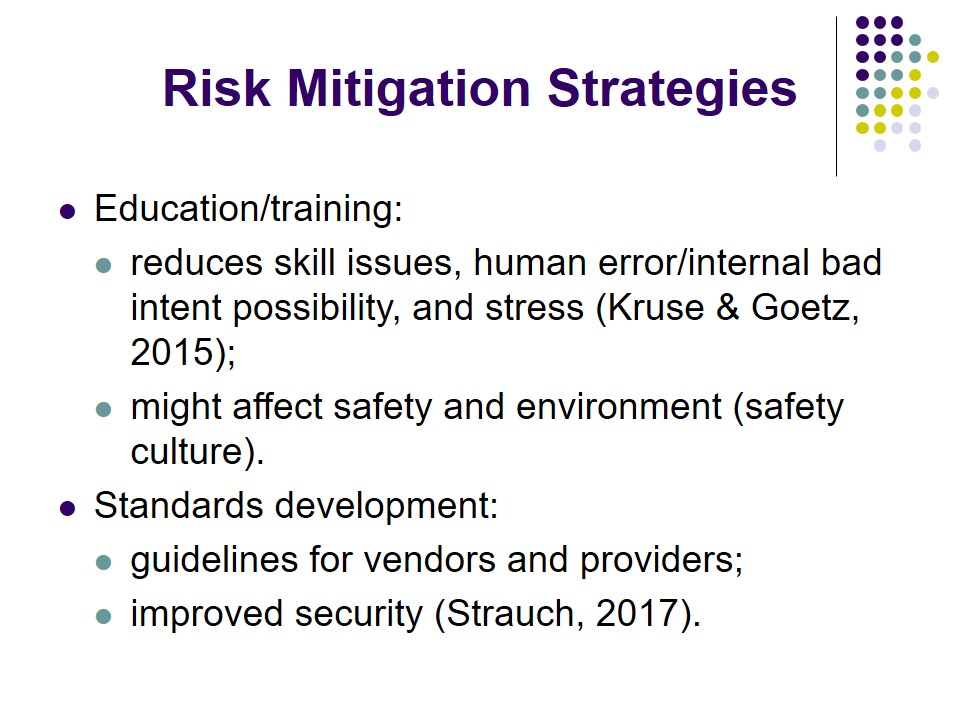
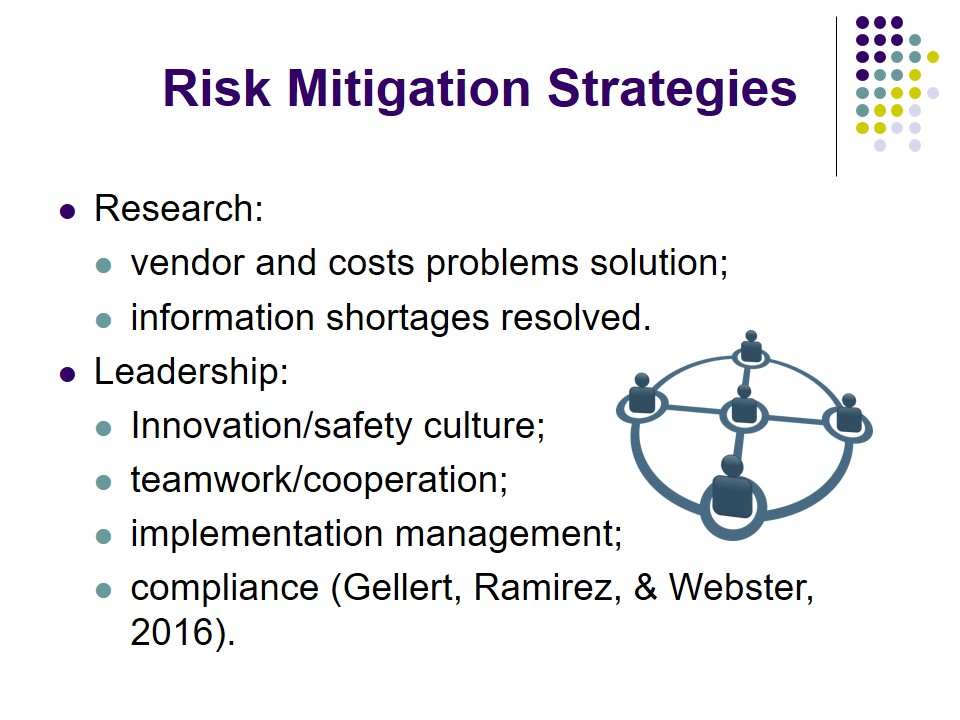
References
Charles, K., Cannon, M., Hall, R., & Coustasse, A. (2014). Can utilizing a Computerized Provider Order Entry (CPOE) system prevent hospital medical errors and adverse drug events? Perspectives in Health Information Management, 11(Fall), 1b.
Forrester, S. H., Hepp, Z., Roth, J. A., Wirtz, H. S., & Devine, E. B. (2014). Cost-effectiveness of a computerized provider order entry system in improving medication safety ambulatory care. Value in Health : The Journal of the International Society for Pharmacoeconomics and Outcomes Research, 17(4), 340–349.
Gellert, G. A., Ramirez, R., & Webster, S. L. (2016). Toward the elimination of paper orders: Managing the challenge of low frequency physician users of computerized patient order entry (CPOE). Applied Clinical Informatics, 7(1), 33-42.
Hoonakker, P. L. T., Carayon, P., Walker, J. M., Brown, R. L., & Cartmill, R. S. (2013). The effects of Computerized Provider Order Entry implementation on communication in intensive care units. International Journal of Medical Informatics, 82(5), e107–e117.
Khanna, R., & Yen, T. (2014). Computerized Physician Order Entry: Promise, perils, and experience. The Neurohospitalist, 4(1), 26–33.
Kruse, C. S., & Goetz, K. (2015). Summary and frequency of barriers to adoption of CPOE in the US. Journal of Medical Systems, 39(2), 15.
Lyons, A. M., Sward, K. A., Deshmukh, V. G., Pett, M. A., Donaldson, G. W., & Turnbull, J. (2017). Impact of Computerized Provider Order Entry (CPOE) on length of stay and mortality. Journal of the American Medical Informatics Association : JAMIA, 24(2), 303–309.
McCartney, P. (2014). Computerized Provider Order Entry (CPOE): Evidence on implementation challenges. MCN: The American Journal of Maternal/Child Nursing, 39(1), 63.
Prgomet, M., Li, L., Niazkhani, Z., Georgiou, A., & Westbrook, J. I. (2016). Impact of commercial Computerized Provider Order Entry (CPOE) and clinical decision support systems (CDSSs) on medication errors, length of stay, and mortality in intensive care units: A systematic review and meta-analysis. Journal of the American Medical Informatics Association, 24(2), 413-422.
Romanow, D., Rai, A., Keil, M., & Luxenberg, S. (2017). Does extended CPOE use reduce patient length of stay? International Journal of Medical Informatics, 97(1), 128-138.
Simon, S. R., Keohane, C. A., Amato, M., Coffey, M., Cadet, B., Zimlichman, E., & Bates, D. W. (2013). Lessons learned from implementation of Computerized Provider Order Entry in 5 community hospitals: A qualitative study. BMC Medical Informatics and Decision Making, 13(67), 1-10.
Snedaker, S. (2016). Leading healthcare IT. Boca Raton, FL: CRC Press.
Soerensen, A. L., Lisby, M., Nielsen, L. P., Poulsen, B. K., & Mainz, J. (2013). The medication process in a psychiatric hospital: Are errors a potential threat to patient safety? Risk Management and Healthcare Policy, 6, 23–31.
Strauch, B. (2017). Investigating human error: Incidents, accidents, and complex systems. Boca Raton, FL: CRC Press.
Wahr, J. A., & Merry, A. F. (2017). Medication errors in the perioperative setting. Current Anesthesiology Reports, 7(3), 320-329.
Yates, C. (Director). (2013). Risk is the currency of innovation [Video file]. Web.